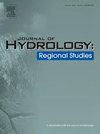沙柳河流域高海拔寒区水源径流模拟与分析
IF 4.7
2区 地球科学
Q1 WATER RESOURCES
引用次数: 0
摘要
研究区域沙柳河流域是高海拔寒区的一个小流域。研究重点使用改进的SWAT模型模拟1960 - 2022年的月径流。采用温度和辐射双因子法对融雪模块进行了优化,对存在多年冻土条件下的地表径流模块进行了优化。以1960 ~ 1964年为模型预热期,1965 ~ 2000年为模型定标期,2001 ~ 2022年为模型验证期。研究量化了流域不同成分对径流的贡献,分析了蓝绿水的变化,评估了气象因子对径流变化的贡献。该研究确定CN2、GW_DELAY、SOL_BD和ESCO是影响年径流变化的关键参数。改进后的SWAT模型在模拟径流方面表现出较好的效果,特别是在融雪期和多年冻土期,其R²提高了0.686 ~ 0.702,PBIAS降低了4.8 %,NSE增加了0.041。融雪贡献率为6.5 %,在春季达到峰值,融雪的贡献率随时间的推移呈减小趋势,基流的贡献率在时间尺度上呈增大趋势。蓝水逐年显著增加,绿水略有减少,绿水系数逐年降低。最高值出现在8月份。从空间上看,绿水中高两端低,蓝水上游高,绿水系数上游低。在流域尺度上,绿水多于蓝水。降水、温度和相对湿度是影响径流变化的主要因素。该研究为寒区流域水资源管理提供了理论依据。本文章由计算机程序翻译,如有差异,请以英文原文为准。
Runoff simulation and analysis of water source in the high-altitude and cold region of the Shaliu River Basin
Study Region
The Shaliu river basin, a small basin in a high-altitude cold region.
Study Focus
An improved SWAT model was used to simulate monthly runoff from 1960 to 2022. The snowmelt module was improved using a dual-factor method of temperature and radiation, and the surface runoff module was optimized under the condition of permafrost presence. The period from 1960 to 1964 was used as the model warm-up period, 1965–2000 as the calibration period, and 2001–2022 as the validation period. The study quantified the contributions of different components of the basin to runoff, analyzed the changes in blue and green water, and assessed the contributions of meteorological factors to runoff changes.
New Hydrological Insights for the Region
The study identified CN2, GW_DELAY, SOL_BD, and ESCO as the key parameters affecting annual runoff changes. The improved SWAT model showed better performance in simulating runoff, especially during snowmelt and permafrost periods, with improved R² 0.686 to 0.702), reduced PBIAS (by 4.8 %), and increased NSE (by 0.041) in the calibration period. The snowmelt contribution rate was 6.5 %, peaking in spring, The contribution of snowmelt is decreasing with time and the contribution of baseflow is increasing on time scales. Blue water increased significantly annually, green water decreased slightly, and the green water coefficient decreased. The highest values were observed in August. Spatially, green water was higher in the middle and lower at both ends, blue water was higher upstream, and the green water coefficient was lower upstream. At the basin scale, green water was more abundant than blue water. Precipitation, temperature, and relative humidity were the main factors affecting runoff changes. This study offers a theoretical basis for water resource management in cold-region watersheds.
求助全文
通过发布文献求助,成功后即可免费获取论文全文。
去求助
来源期刊

Journal of Hydrology-Regional Studies
Earth and Planetary Sciences-Earth and Planetary Sciences (miscellaneous)
CiteScore
6.70
自引率
8.50%
发文量
284
审稿时长
60 days
期刊介绍:
Journal of Hydrology: Regional Studies publishes original research papers enhancing the science of hydrology and aiming at region-specific problems, past and future conditions, analysis, review and solutions. The journal particularly welcomes research papers that deliver new insights into region-specific hydrological processes and responses to changing conditions, as well as contributions that incorporate interdisciplinarity and translational science.
 求助内容:
求助内容: 应助结果提醒方式:
应助结果提醒方式:


